What are the chimney gates and how to install them?
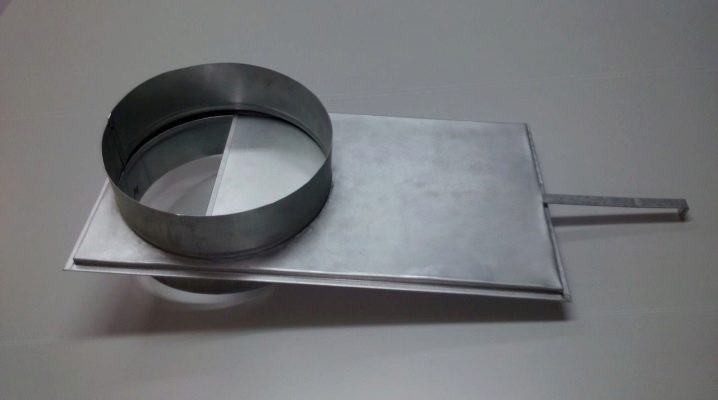
Designing modern boiler or stove heating systems requires thinking through all the components - none of them, even the smallest at first glance, is superfluous. The safety of residents of a country house depends on compliance with building codes and regulations for arranging a heating system. In the article, we will consider what kind of chimney gates are, and how to install them.

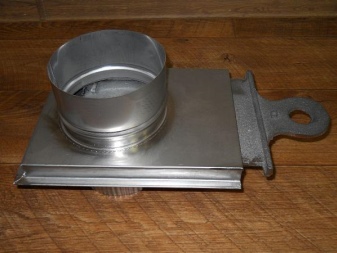
What it is?
A chimney damper or, more simply, a damper is used to regulate the draft. Next, we will talk in more detail about why it is needed and how it is exploited.
In order for a country house with stove heating to be extremely comfortable during the winter, proper care of the heating system is needed. In country and private city houses, where heating with wood or organic waste is used, they try to adjust the draft as much as possible so that the fireplace or stove works with full efficiency.
The combustion intensity is regulated by a damper.
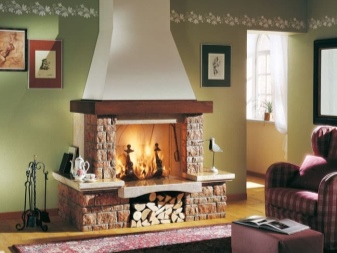
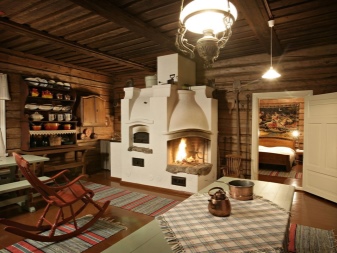
The peculiarity of using the gate is that the weakened thrust excludes the effective ignition of fuel, whatever it consists of, be it even firewood mixed with plastic bottles and bags. Incomplete combustion leads to deteriorated heating of the room in which the stove is installed. In addition, ineffective traction is a fire hazard. To exclude many times the danger of fire, a slide damper is used, which is installed in the chimney.
The gate device is as follows. This is a cast iron or stainless steel plate. The retractable device makes it possible to set the optimal traction. For example, when the goal is to transfer the stove to a mode of long burning (smoldering) of firewood, then the lumen is blocked by more than half or 2/3 (or 3/4) of the original parameters of the chimney. If you leave the gap completely open, the firewood will burn out quickly, in a maximum of an hour, the stove will heat up and quickly warm up the room where it is built, but just as quickly it will cool down when there is frost and wind outside the window. By blocking the gap almost completely, the owner will weaken the traction. The gate barrier is placed inside the room where the stove is located, at some distance (for example, a meter) from the upper edge of the firebox. It is a necessary part of the chimney. The damper allows smoke to be removed, resulting in a safe use of the heating system.

The damper allows, by blocking most of the waste gas flow, to prevent the release of, for example, soot residues into the chimney. The use of the gate is conditioned and justified in the conditions of a furnace operating on gases, liquid and semi-solid oil products, bulk combustible materials. Such a component is controlled manually or with the help of hydraulics / electrics. The gate damper is widely used in the construction of chimneys and air ducts (ventilation ducts). A distinctive feature from other components is the final absence of an open pipe inside this component.
This device provides little resistance to the residual gaseous content, which tends to finally leave the chimney.
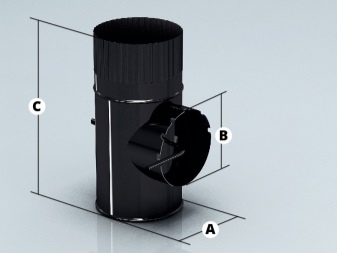
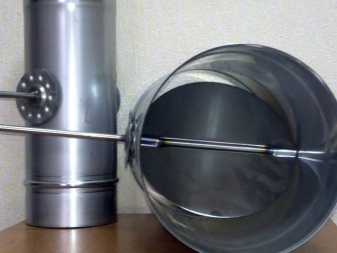
Specifications
The gate is made in the form of a steel or cast iron component. The thickness of the sheet used in its manufacture is no more than 1 mm. The upper layer of the damper is polished to an extremely smooth state, which makes it easier to clean the element from soot deposits. Stainless steel and cast iron can freely withstand heating temperatures up to 900 degrees. The extremely flat surface makes it possible for the thrust to remain at a high level, while the gases spent during the combustion of fuel freely pass through the chimney outside the house. The gate component resists corrosion well, is strong and reliable, expands minimally when heated to the same 900 degrees. The low specific expansion minimizes temperature fluctuations that would otherwise lead to premature "fatigue" of metal components.
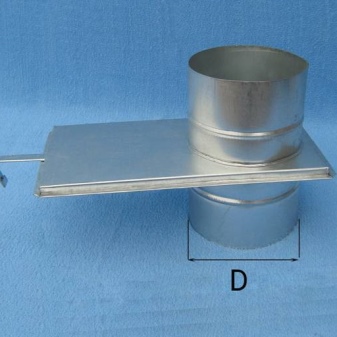
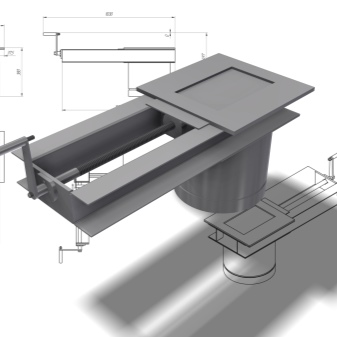
A steel or cast iron gate is highly heat-conductive, which makes it possible to use it as part of one of the components in furnace heating. Butt welds on chimney dampers with a diameter of 110 to 150 mm are made using a rolling method. An ordinary iron flap, fabricated from stainless steel, blocks the smoke gap by about 86%, this makes it possible for carbon monoxide to fully burn out to carbon dioxide. Safety for people who, for example, came to take a steam bath, will significantly increase. Materials other than stainless steel and cast iron are unsuitable for the use of raw materials for the manufacture of gates. In terms of durability, strength, corrosion resistance, it is stainless steel that is in the lead. Cast iron is susceptible to corrosion, but compared to simple rusting steel, for example, black, it is significantly ahead of it in terms of resistance to rapid oxidation.
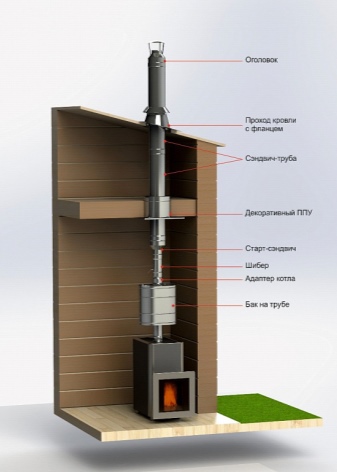

Cast iron gates are heavy, but they are ahead of stainless steel in terms of service life. The fact is that with significant overheating - up to 900 degrees - stainless steel, like any steel, forms scale on the surface, which is why it becomes thinner over time. If you overheat the stove, transferring it to a mode, for example, burning waste rubber, which emits a lot of heat during combustion, then the stainless steel in the slide gate with a sharp increase in temperature, say, above 1300 degrees, will lose its properties and can become simple rusting steel, and the cast iron will simply melt, and nothing will remain of your gate. The increased weight of cast iron makes it possible to install such a gate on the most massive chimneys, since after installation, a noticeable pressure is exerted on the entire structure under its own weight of the gate component.
A cast-iron gate is preferable to use in pipes, folded, for example, from high-temperature fireclay bricks, or from ceramic blocks.

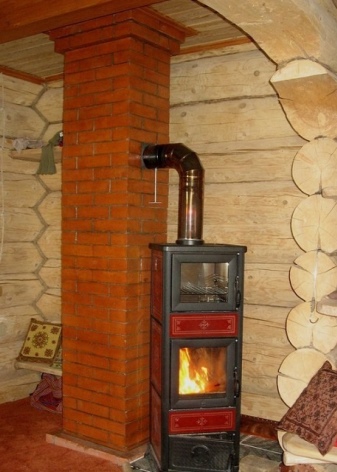
"Corrosion-proof" dampers are much more in demand - they are much easier to install in a pipe. Their installation is simplified - as well as operation, maintenance. The heat they can withstand is quite significant: you can heat the stove to noticeable limits, ensuring that your home warms up quickly during the harsh days of winter. At the same time, the efficiency of the heating system reaches 90% - this is a solid indicator, because 40% of the heat, as in the operation of a simple stove without a gate, does not fly out. To make the plate (shutter) easier to clean, check it upon purchase: it should be as smooth as possible, without scratches and notches.
Personal preferences when choosing a gate do not play a noticeable role. Basically, the choice is made based on the chimney device.

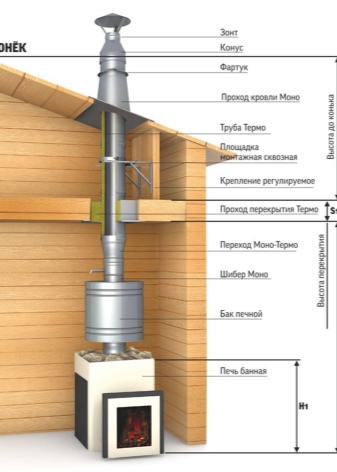
Types of gate valves
The selection of a suitable damper is made according to the classification criteria. It can be welded or automatic (controlled by a hydraulic or electric drive circuit). The design itself divides these components into two main types.
Retractable
The retractable design allows for adjustment when the damper is extended. It will lead to a change in the area of the chimney lumen. It is placed horizontally in pipes made of fire-resistant bricks.Certain types of retractable gate are used as special devices combined with stainless steel chimneys. Holes are cut in the plate of the retractable gate, which allow the exhaust gas to pass partially, even when the damper is completely closed. According to SNiP and PPB, such a feature is permissible - a blind damper should not be used, since there is a risk of accidentally blocking the gap completely, by 100%, and the fire, at best, will go out, at worst - the tenants of the country house will suffocate at night.
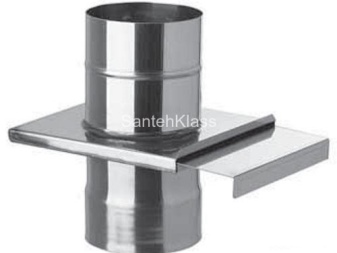
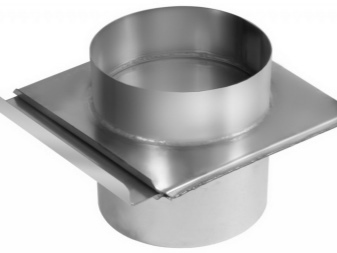
Rotary throttle
This variety differs from a simple manual (retractable) gate plate by the presence of a swivel mechanism. The gate itself is fixed on a rotating axis, and has a structure that rotates in the pipe lumen. Distantly resembles a ball valve - according to the principle of operation, however, the partition there is not a ball with a hole, but a round partition, almost touching the edges of the pipe lumen with its edges.
Pushing in and out of this damper is not required.

However, the butterfly valve also has one or more holes to prevent carbon monoxide poisoning when it, unable to find a way out, begins to accumulate in the pipe and stove and sinks. The butterfly valve is easy to mount - everything is already ready in the factory, and you do not need to additionally search for and install additional components. The disadvantage of a rotary damper is a rotary mount that weakened from periodic overheating, over the years it rotates worse. It is forbidden to put it in the bath - it partially lets steam into the chimney from the steam room. The second drawback is that the rotary gate does not regulate the internal clearance of the chimney, but only opens and closes it as much as the design allows. It can, of course, be turned into? turnover, closing the gap only half, but in factory assemblies there is no such convenience: the throttle valve works exclusively as a valve valve. Finally, it is much more difficult to clean the chimney due to the rotating gate valve.

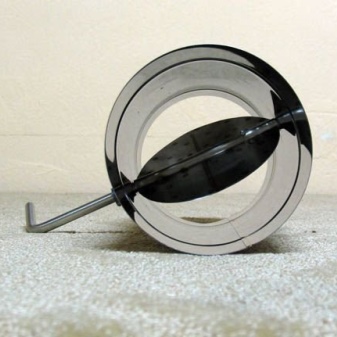
Installation
Installing a gate on the chimney is possible only by using one of three possible options:
- in the firebox;
- by the method of inserting one pipe into another;
- in the ventilation duct.
In the firebox. The gate structure can be built into the outlet. The damper is located no further than a meter from the grate of the furnace. This simplifies the control of the damper: the facing and portal of the stove or fireplace do not bump into the adjustment knob. Additional transition elements are not used here: one section fits snugly into another.

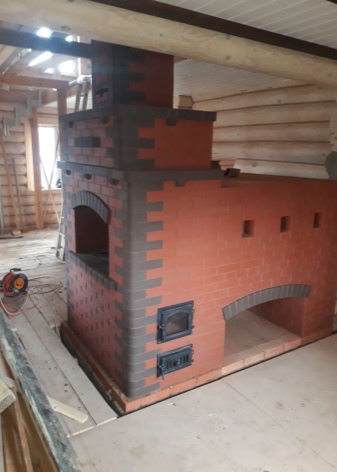
The gate can also be installed in the ventilation duct. A fan is placed at the outlet of the duct. In the starting vane device, the fan and the damper are installed at the same time. The gate becomes, as it were, a protective plug that prevents the motor from overheating when the fan starts. You can start the engine with the gate locked - if you do the opposite, the running engine will undergo a significant load.
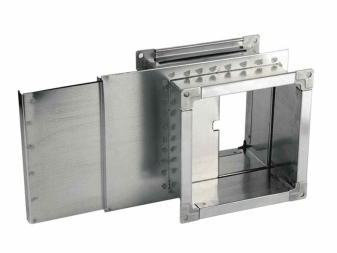
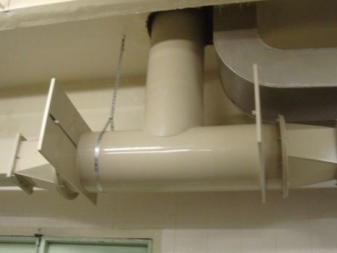
In the presence of the initially straightened chimney, the damper does not allow the accumulated soot to be quickly and promptly removed. A gate that does not have the ability to auto-open requires retrofitting the fan with a slow start device.
The insertion of one section into another is used when using a metal structure as a chimney. Additional support points are not required - the stainless steel sectional chimney is held in this way.
After purchasing off-the-shelf components, place the damper without deviating from the advice of the product supplier.
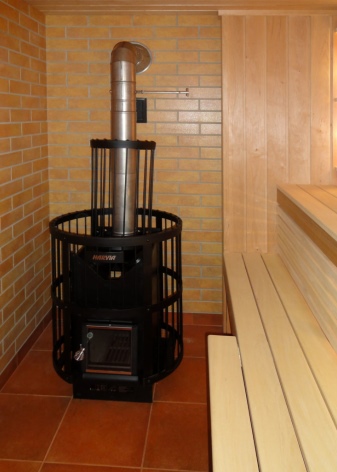
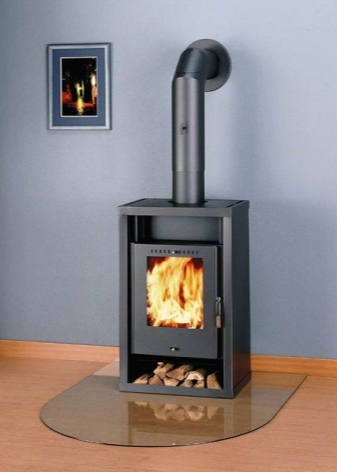
To make a gate yourself, with your own hands, you will need the following tools and materials:
- grinder with a set of cutting discs for steels;
- a drill with a set of drills necessary for work;
- taps for threading and machine oil;
- hammer, pliers, tape-type building ruler and marker;
- compass;
- welding inverter and a set of electrodes;
- locksmith's vice (it is desirable that they were already mounted in your workbench);
- grinding and grinding wheels with electric grinder;
- construction marker, core;
- domestic or foreign stainless steel sheet (at least 2 mm thick);
- 6 mm stainless steel tube;
- bolts М8;
- metal rod for the manufacture of a frame element.
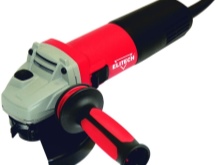
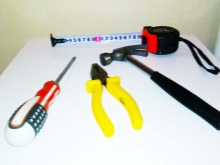
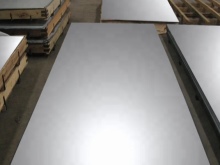
You can find ready-made drawings of the gate, or create your own version. Dimensions from the drawing are taken with extreme accuracy, avoiding an error of more than 1 mm. If the error exceeds this limit, then the chimney will not work satisfactorily. Now do the following.
- Measure the inner circumference of the chimney with a tape measure - and calculate the cross-sectional area of the chimney.
- Add to the result (length) an average of 2.5 cm - this will be the outer length of the frame.
- Cut out a gap in the finished damper for the flue gas outlet.
- Mark the position of the weld holes.
- Write down the obtained dimensions of the gate separately - you will need them.
- When arranging the laying of a brick pipe, mark the place for the gate - at an average height of about 7 rows of bricks, taking into account the seams between the rows and the elements of the layout itself. At the same time, the frame will be located straight, without covering the lumen of the chimney with its contour. If you are working on a stainless steel chimney, then the gate is installed in the chimney, assembled stably from the sections of the latter. Match the size of the damper with the inner diameter of the smoke opening. The damper must be installed on an unprotected section of the chimney. The height of the valve from the floor is about 1.8 m, not higher, this is necessary for ease of adjusting the gate.


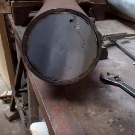
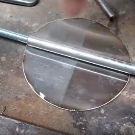
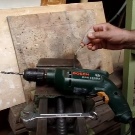
The gate in the groove gaps should move without much effort. If you put the damper on the insulated pipe, then the structure will not give off excess heat, and this partition will finally hang, not succumbing to attempts to crank or move it. Installation errors are as follows:
- a rotary damper must not be installed in a steel chimney;
- thin steel - less than 1 mm - will burn out quickly, in a matter of months;
- non-smooth edges of the gate will make it difficult to clean them;
- the absence of a hole for the release of carbon monoxide is fraught with poisoning of the owners of the house.
To easily use the gate structure, its handles should be as comfortable as possible - a person regulating traction should not get burned when trying to move or turn the damper.

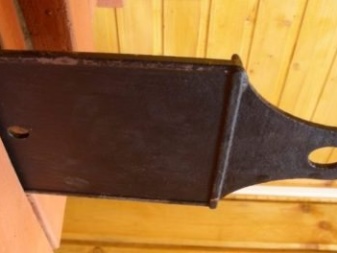
Service
The gate can be serviced as follows.
- The horizontal vane is cleaned by removing it and applying a soot dissolving agent. However, the stainless steel can be washed freely.
- The rotary gate is cleaned with a brush.
- Check the free play of the slide valve regularly. The guides should not catch on it, leading to a jam. The guides also need to be cleaned and lubricated - this will provide the entire gate structure with ease of movement.
- In order for the stove to cool down faster after the flame has gone out, the damper can be partially opened.
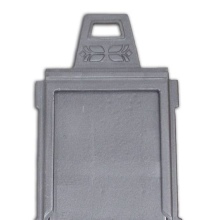
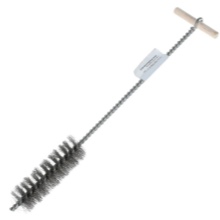
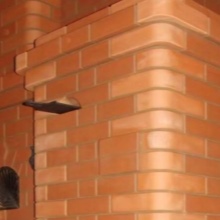
If you use a heating boiler, then in modern models you can do without a gate: the design of models released in the 2010s provides for auto deflectors. In other cases, it is necessary to install a gate.













The comment was sent successfully.